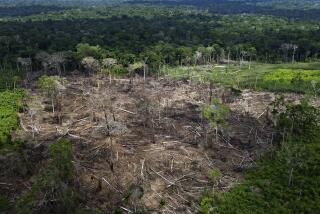Say cheese for science: Camera traps show how habitat protection aids biodiversity
Researchers have some good news for the animals struggling to survive in the world’s tropical forests: Setting aside habitat for their protection does more to protect biodiversity than scientists had realized.
And there are photos to prove it.
To get a better picture of how mammals and birds were faring in the tropics, the authors of a new study set up more than 1,000 “camera traps” throughout 15 protected areas in Central and South America, Africa and Southeast Asia. The cameras snapped a picture whenever they detected motion nearby.
Over eight years, these cameras captured 2.5 million pictures of 244 species of mammals and birds on the forest floor. That allowed members of the Tropical Ecology Assessment and Monitoring Network to track the type and number of animals that lived in the areas where the traps were set.
In a real sense, the researchers were able to witness changes in tropical biodiversity for themselves.
After combing through all those images, they saw that 22% of the mammal and bird populations they observed decreased over time. However, an additional 22% of them remained the same and 17% of them grew, according to a report published Tuesday in the journal PLOS Biology.
“We weren’t expecting good news, but we found it,” said lead author Lydia Beaudrot, an ecologist and conservation biologist at the University of Michigan in Ann Arbor.
“While there could still be bad news for any given species or population, at the community level, it’s good news,” she added. “We’re seeing stability.”

Endangered animals were spotted nearly as often as common ones. That suggests endangered species are faring well in protected areas.
The researchers also analyzed the data according to animal size and what they ate. They found no major declines in any particular body size or diet type, suggesting balance among predatory and prey animals.
Nearly 40% of the species that the researchers set out to study were caught by the camera traps fewer than five times per year. Those detections were too infrequent for the researchers to gauge whether the populations were stable or not.
Tropical species are elusive by nature. Still, it’s possible that hunting or habitat loss could have contributed to their infrequent appearances in front of the cameras, Beaudrot said.
Tropical mammals and birds help forest ecosystems tick. Their loss, called “empty forest syndrome,” can undermine these ecosystems and ultimately hurt human well-being.
The results demonstrate that protected areas can be an important tool for conservation. But only 13% of the world’s land is set aside for this purpose, the study authors noted. That’s “likely insufficient to stem the ongoing global extinction crisis,” they wrote.
On a more practical level, the work demonstrates that camera-trap data can provide useful, reliable data for conservation studies. “The gravity of conservation decisions necessitates more objective evaluations,” the researchers wrote.
That’s especially useful for studying tropical areas, which are difficult to monitor in person because of remote locales, government permits and the complexity of such ecosystems, Beaudrot said. Hopefully, she added, the open access images can help experts meet biodiversity conservation targets.
“This is the first time in such a large-scale way that we have assessed biodiversity with real data,” she said. “Big Data has transformed society.… Why not conservation?”
Follow me on Twitter @seangreene89
MORE SCIENCE NEWS
What makes a chimpanzee a BFF? Trust, study finds
When air is polluted, homing pigeons find their way home faster
Toxins from algal blooms may cause Alzheimer’s-like brain changes







